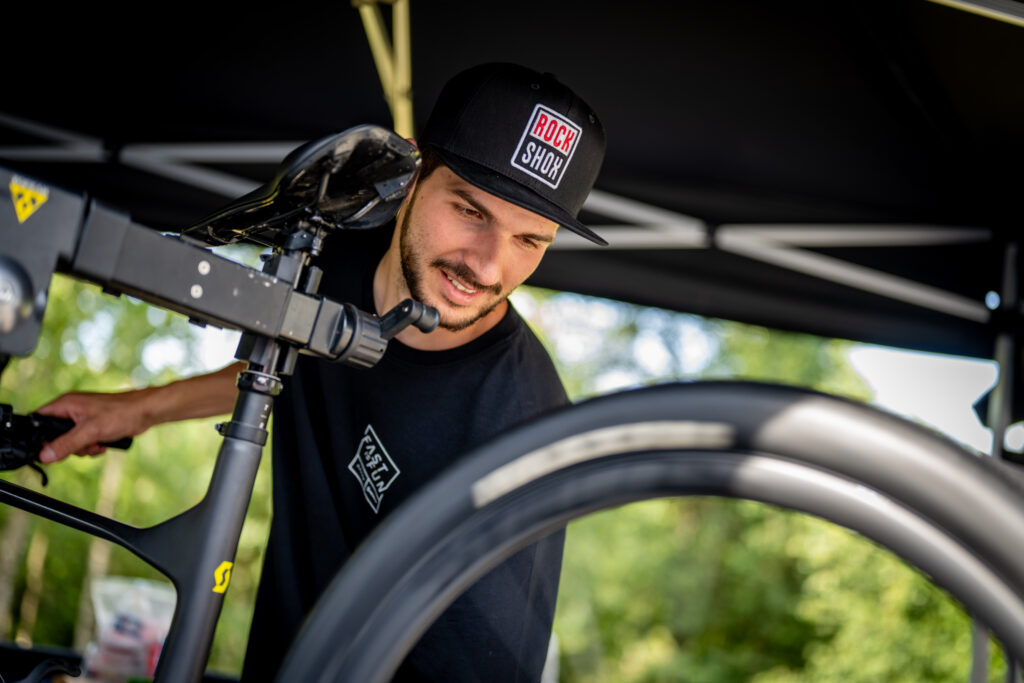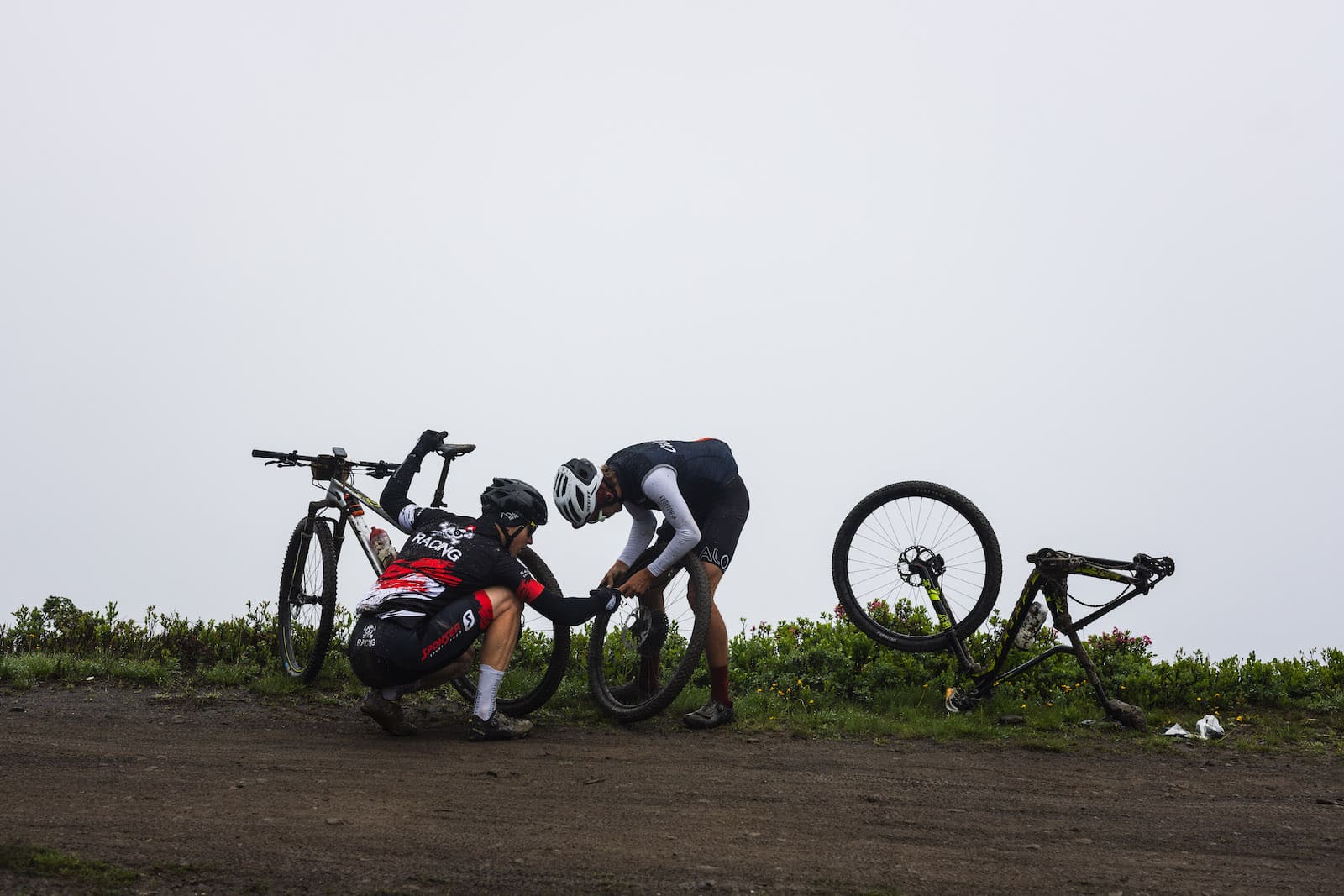July 3 to 5, 2026
Pre-race equipment preparation is essential to anticipate mechanical problems. After days, weeks and months of preparation and training to exceed your limits, you don’t want everything to be ruined by a mechanical problem that could have been avoided. A badly adjusted derailleur, incorrectly bled brakes or the omission of an essential tool such as a pump or inner tube can bring your effort to a premature halt at a time when your legs were on fire.
That’s why Lucas, a mechanic at SCOTT, insists: “It’s not just yesterday that you prepare a bike for a race like this.” Here’s how to put the odds in your favor, by preparing your machine like a pro.
As early as a week before the start of the race, we enter race preparation mode.
This timing is strategic: it allows us to spot any faults, order a part if necessary, or simply adjust the settings without stress.
Start with an overview of the frame. Check the joints and tighten them to the manufacturer’s torque using a torque wrench. The aim: no play, no nasty surprises. Then examine the frame for cracks, impacts or signs of fatigue – a reflex you should adopt regularly, not just before the MB.
Turn the handlebars. You shouldn’t feel any hard spots or suspicious creaking. If the steering shows signs of weakness, it’s best to deal with it immediately. Finally, inspect the wheel axles: tight, no wobble.
On the descents of the MB Race, you’ll be putting your brakes under extreme strain. They need to be in top condition. Remove the pads to inspect the lining, following the manufacturer’s recommendations. Discs also have something to say: their minimum thickness is often engraved on them. If they’re too thin, don’t hesitate to change them.
Check all fittings, joints and hoses for leaks. And make sure your brakes have been bled recently – a spongy brake means one less brake. Last but not least, to avoid friction that can impair performance, check that the discs are not warped and that the calipers are perfectly centered.
Little tip from Lucas: tighten your brake levers (around your handlebars) just enough. They must be able to pivot slightly in the event of a fall, to avoid breakage.
A cracking or skipping transmission will raise your pulse – and not in a good way. If you’re riding electronically (AXS type), make sure you’ve got at least one spare battery in your pocket. And even two if you’re the cautious type.
Inspect the condition of cables and sheaths, especially those on the telescopic seatpost. If they scratch or catch, it’s time to replace them. As for the chain, cassette, chainrings and derailleur rollers, use a wear tester (€10-15 in stores) to judge. A tired transmission means a temperamental bike.
Remember also to check the derailleur hanger: bent or damaged, it will distort all settings.
Turn your crankset by hand: it should feel smooth, with no hard points or damaged bearings. The same goes for the wheels: spin them and look for any significant warping or jumping. All spokes should be tight, and rims watertight if you’re riding tubeless.
Lucas draws your attention to a specific point: if you feel play in the hubs, it could be due to either loose end-caps or tired bearings. In both cases, you’ll need to rectify the situation.
Inspect the condition of the tires carefully: no cuts, hernias or areas of excessive wear. Top up with preventive fluid to secure your tubeless mounting, and don’t forget the valve obturator: if it’s clogged, repairing a puncture will become a living hell.
Examine your fork and shock absorber plungers. Chips or snags can damage the seals, allow impurities to enter, and ultimately cause breakage. The handlebar locking system (if you have one) must be functional: test the cable, sheath and control.
Adjust the pressure (SAG), rebound and compression according to your weight, riding style, and terrain. Lucas advises not to upset things the day before: “In MB, we ride with what we know.”
A misaligned hanger can create real parasitic sensations. To center, align it visually with the fork T, making sure that you have the same gap on each side. Also make sure that all the controls are naturally at hand: levers, joysticks, seat post control.
The handles should not be neglected. Choose a comfortable model, adapted to your habits. And for the saddle, it is the same golden rule: do not change anything before the race.

Crédit photo : Rémi Fabregue
You’ve done most of the work. Now for the final adjustments.
Start by lubricating your chain, always on the inside side – it’s the one that is in contact with the transmission. Let it sit for a while so that the lubricant permeates well. Choose an oil adapted to the weather: dry, wet, mixed? It’s a detail that makes the difference.
Recharge all your batteries: transmission, GPS, lights, phone. Test braking, make sure the discs don’t rub. Adjust your tire pressure. And do not forget the pads adapted to the conditions of the next day (attention: they require a small lapping, count 25 braking supported by 25 km/ h at standstill).
The stress increases, but stay methodical. Recheck the tire pressure, adjust your suspension if necessary. And most importantly, make a point of matos.
Essential checklist:
With this equipment, you are ready to face a lot of the problems that can arise on a race as demanding as the MB Race.
But you still have to know how to use it!
That’s why Lucas insisted on sharing his “5 tips for getting started”, simple gestures to master during the race and which can help you avoid abandonment.
Field tip: if you are in a hurry, slightly inflate the chamber before placing it – it will better shape into the tire.
Little extra: practice doing it at home without stress. Once in the race, your hands will tremble a little more…
Bonus tip: have a small Allen key handy in your jersey.
You have the magic recipe so that nothing can stop you from crossing the finish line of the famous world’s most difficult mountain bike race.
«After, it’s mostly a story of legs» will add Lucas laughing.
Good race to all!
